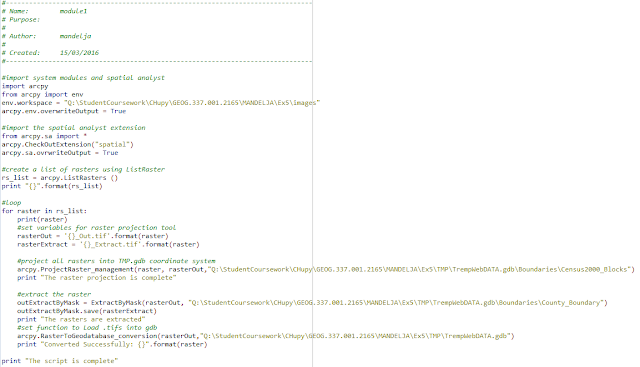Lab #5: Data Downloading and Management
Introduction:
The goal of this activity is to become familiar with the
process of gathering data in different formats from different providers online
and using them in ArcMap. To do this one has to be able to join and project
that data into the same coordinate system as well as designing and building a
geodatabase to hold that data. The downloaded and managed data is then to be
turned into displays illustrating different aspects of Trempealeau County
topology.
Methods:
1. 1)Download the data.
a.
Data was gathered from the following sources to
conduct maps of Trempealeau County.
b.
US Department of Transportation-Bureau of
Transportation Statistics-Railway Network
c.
USGS National Map Viewer-National Land Cover
d.
Trempealeau County Land Records-Land Use
e.
USDA NRCS Web Soil Survey-Soils Data
f.
USGS-Elevation in High resolution
g.
Accuracy of this data in a comparison table is
below as figure 1.
Figure 1: An Excel table comparing accuracy to data sources used in this activity.
2)These different DEMs. TIFs, and mosaic files had
to be put into a constructed geodatabase so that they could be managed easiest.
Several tools and several attempts were gone through in order to arrive at the
goal of having all rasters combined in one area in the geodatabase. The rasters
also all had to be in “.tif” format to enable combinations and loops to be run
on them in Python. Once in “.tif” format they were placed in the same location
in the geodatabase. Entitled “images”, the .tif folder enabled a Python script
to locate and manipulate the images.
3) The data is then imported and joined based on
common attributes so that it can be displayed. This is done using a Python
script, the script is figure 2.
Figure 2: The Python script for combining and extracting the rasters.
4)The output of the script run created the images
needed to display crop type, land use, and elevation. A map of each is below as figures 4-6 with a locator map of Trempealeau County Wisconsin as figure 3.
Figure 3: Trempealeau County in Wisconsin-the area of interest.
Figure 4: An elevation map by meters of the county.
Figure 5: Land Cover in Trempealeau County.
Figure 6: Crop type from the USDA dataset.
Discussion and Conclusion:
The resulting maps display the wealth of knowledge and
information that can be gathered from just one county in Wisconsin. This project
displays the use of online resources to create products that can be used for
multiple different analysis of the land. This particular group of data will go
towards analyzing frac sand mines across the county but there are more
applications and the method of collecting and organizing the data was a great
step farther into online data management. There were some errors as far as data
accuracy goes, the metadata was not always consistent or accurately recorded
which could leave holes in an argument propped up by the data. The biggest
issue with this lab happened when running the python script. There were several
attempts to complete the script and correct the multiple errors. Errors occurred
in file naming, a selected file started with a number which cannot happen. File
location was also an issue as files must all be in the same folder in the same
geodatabase and in the same format in order to run the “loop” that was needed. Eventually
the issues were resolved but this was certainly the most difficult segment of
the lab.






No comments:
Post a Comment